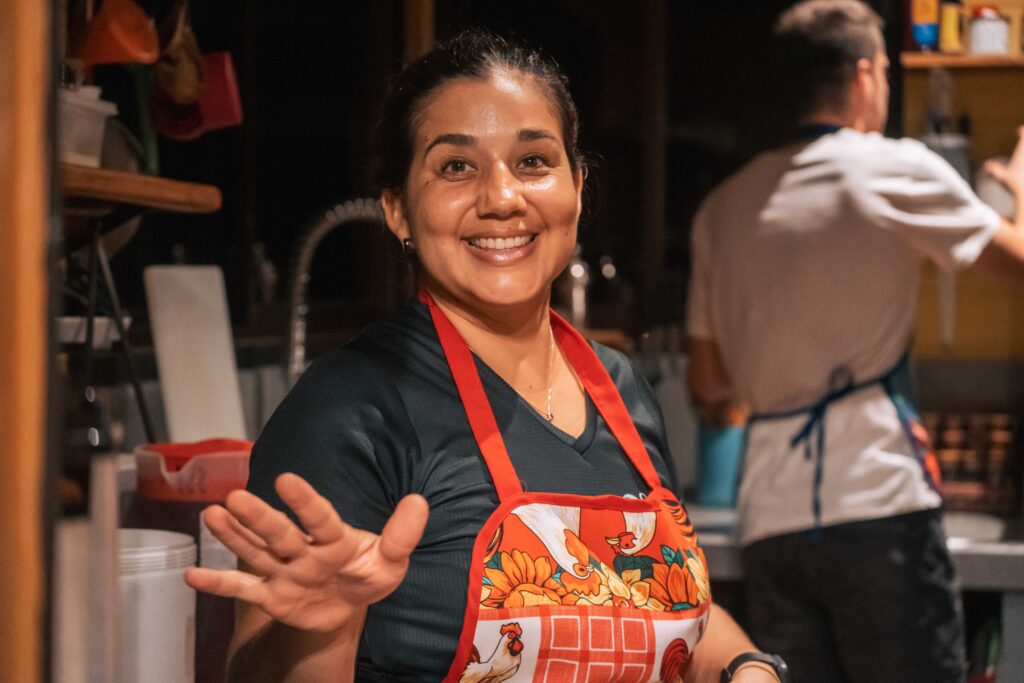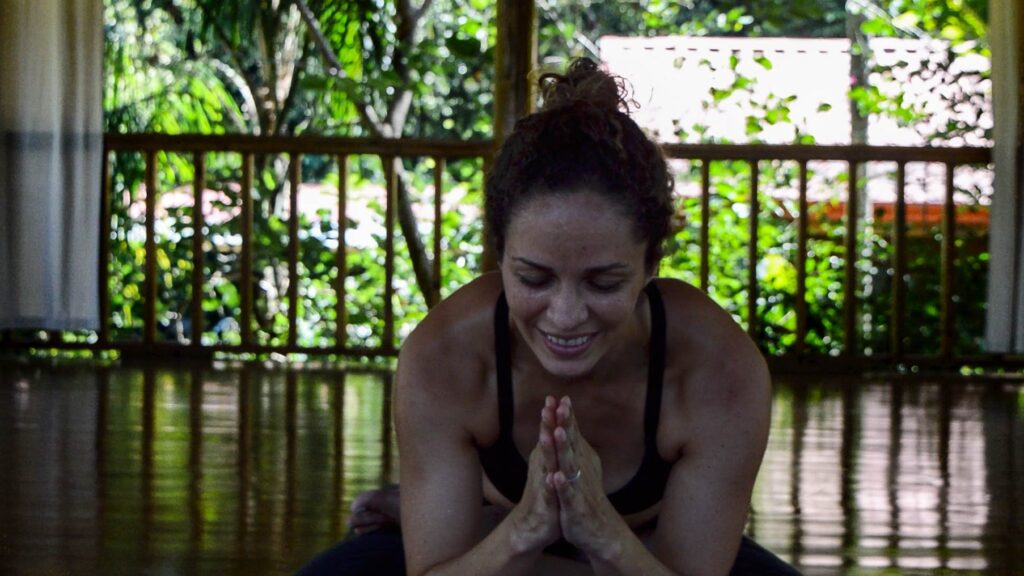For those of you who want to start yoga but don’t know where to begin, Sun Salutations are the best answer.
Sun Salutations, also known as Surya Namaskar, is a beginner-friendly sequence of yoga poses that will help stretch, strengthen, and energize your body.
Compared to advanced yoga sequences, these poses primarily focus on warming up and improving spine flexibility. Nonetheless, they’re still a full-body workout on their own.
Here, you’ll find a step-by-step guide with modifications to help you adapt this practice to your body and, hopefully, your daily routine. So, take a deep breath, and let’s start!
What are Sun Salutations?
Sun Salutation, or Surya Namaskar in Sanskrit, is a sequence of yoga poses traditionally completed in the morning to welcome the rising sun.
You’ll find this to be a key element in many yoga styles, as it’s perfect for warming up before various activities like surfing, or even as a standalone 10-minute practice.
The fundamental sequence of Sun Salutation consists of 12 poses, which are performed in a fluid and continuous manner, synchronized with your breath.
The sequence typically starts and ends in a mountain pose (a standing pose), with each pose flowing into the next effortlessly.
To fully feel the benefits of the Sun Salutations you need to understand how closely tied they are to your breathwork during the sequence.
You see, the amount of breaths you take in each pose determines the speed of the sequence. It’s also important to breathe deeply and completely with each inhale and exhale.
That means you can’t rush a pose or breath too quickly or hurriedly as each pose is connected to an inhale or an exhale. Still, you’re allowed to take three complete breaths in each pose to slow down the sequence if you’re feeling overwhelmed.
Benefits of Sun Salutation for Beginners
When you start practicing Sun Salutations, you’ll feel a wide range of physical and mental benefits as time goes on. These benefits include the following:
- Increased Flexibility: With the various muscle groups you stretch in the different poses, you end up enhancing your overall flexibility.
- Improved Circulation: Because this is an exercise—even if it’s a 10-minute one—the movement boosts your heart rate, promoting better blood flow throughout your body.
- Reduced Stress And Anxiety: As you start the poses, you need to be mindful of your breathing, movements, and the next step to follow. This can help relax your mind and take it off of all things in the outer world.
- Improved Digestion: There are certain poses in the Sun Salutations sequence that can massage your abdominal organs, aiding in better digestion.
- Strengthened Muscles: With all the dynamic moments you engage during the practice, you end up improving your strength and strengthening your muscles.
- Increased Lung Capacity: The deep, rhythmic, and controlled breathing exercise you perform can help your lungs greatly, improving their general capacity and efficiency.
- Improved Balance And Coordination: You’ll find certain poses require maintaining your balance. With constant practice, these poses can eventually help you enhance your stability and coordination.
- Better Sleep: The stress-relief benefits of Sun Salutations contribute greatly to a more restful and restorative sleep cycle.
- Improved Focus And Present-Moment Awareness: Sun Salutations take you away from social media and the real world and force your attention to each pose and breath. This promotes mindfulness and can help sharpen your focus.
Step-by-Step Guide to Sun Salutation for Beginners

Step 1: Mountain Pose (Tadasana)
- Lay your mat flat on the floor and stand tall with your feet hip-width apart. Some start with their feet close together but for a beginner let’s go with hip-width apart.
- Distribute your weight evenly on both feet. That means don’t lean on one foot more than the other.
- Stretch your spine and engage your core.
- Relax your shoulders and let your arms fall to your sides.
- Take a few deep breaths.
Make it your own: Make a soft bend with the knees to avoid hyperextending. Close your eyes to turn your focus inward and let the outside world fade away.

Step 2: Upward Salute (Urdhva Hastasana)
- Inhale gently and raise your arms overhead.
- Bring your palms together in a prayer position.
- Slowly arch your back and look up.
- Keep your shoulders relaxed and away from your ears.
Make it your own: If your shoulders are tight, separate the palms to form the uppercase letter “Y.” If looking up is hard on your neck, keep your gaze forward instead.

Step 3: Forward Fold (Uttanasana)
- Exhale and fold forward from your hips.
- Keep your spine long and your chest open.
- Let your head hang freely.
- Relax your neck and shoulders.
Make it your own: Place a generous bend in the knees to reduce tension on the lower back, or use your hands on your hips to support you. Only fold as much as your lower back allows comfortably, resting your hands on your thighs, shins, or yoga blocks for support.
Step 4: Half Forward Fold (Ardha Uttanasana)
- Inhale and lift your torso halfway up.
- Stretch your spine and engage your core.
- Keep your hands on your shins or thighs.
- Look forward.
Make it your own: If your hamstrings feel a tad tight, place your hands on the yoga blocks for more support.

Step 5: Plank Pose (Phalakasana)
- Exhale and step back into a high plank position.
- Your wrists should be directly under your shoulders.
- Engage your core and legs.
- Keep your body in a straight line from head to heels.
Make it your own: You can also do this pose with your knees touching to build strength and slowly reduce tension on the wrists. Similarly, you can come into a tabletop pose, reducing the core strength required.

Step 6: Low Plank (Chaturanga Dandasana)
- Lower down from high plank to low plank.
- Keep your elbows close to your sides.
- Keep your body in a straight line from head to heels.
- Exhale as you lower down.
Make it your own: This can be done with the knees touching to support you. If you were in a tabletop position, slowly lower yourself down to the floor in a comfortable way.

Step 7: Upward-Facing Dog (Urdhva Mukha Svanasana)
- Inhale and roll over your toes.
- Lift your chest and straighten your arms.
- Keep your thighs and knees off the ground.
- Lower your shoulders away from the ears.
- Look forward or slightly up.
Make it your own: If your lower back feels tight, keep your hips on the floor and practice low cobra. Keep your hands on the ground under your shoulders for support, and lift only as much as feels comfortable to your lower back.

Step 8: Downward-Facing Dog (Adho Mukha Svanasana)
- Exhale and lift your hips up and back.
- Straighten your arms and legs.
- Press your palms and heels into the ground.
- Relax your neck and shoulders.
Make it your own: An alternative here is a child’s pose. Keep your knees on the ground, spread them wide, and sit your hips towards your ankles. Stretch your shoulders by extending your arms out in front of you on the floor, spreading your fingers wide.

Step 9: Half Forward Fold (Ardha Uttanasana)
- Inhale and step forward between your hands.
- Lift your torso halfway up.
- Lengthen your spine and engage your core.
- Look forward.
Make it your own: Consider this your “I’m almost there” point where you need to reset, find your balance, and prepare for the next move.
Step 10: Forward Fold (Uttanasana)
- Exhale and fold forward from your hips.
- Keep your spine long and your chest open.
- Let your head hang heavy.
- Relax your neck and shoulders.
Make it your own: You can add a little adjustment by bending your knees just slightly to avoid any strain on your lower back and hamstrings.
Step 11: Upward Salute (Urdhva Hastasana)
- Inhale and raise your arms overhead.
- Bring your palms together in a prayer position.
- Gently arch your back and look up.
- Keep your shoulders relaxed and away from your ears.
Make it your own: If you feel that your shoulders are tight, keep your arms shoulder-width apart instead of bringing your palms together. This adjustment can help you acclimate to the pose until your body adapts.
Step 12: Mountain Pose (Tadasana)
- Stand tall with your feet hip-width apart.
- Distribute your weight evenly on both feet.
- Stretch your spine and engage your core.
- Relax your shoulders and arms by your sides.
- Take a few deep breaths.
Make it your own: As with the first step, make a soft bend with the knees to avoid hyperextending.
Repeat on the Other Side
Once you have completed the Sun Salutation sequence on one side, it’s time to repeat the same sequence on the other side of your body.
Start by stepping your left foot back into a lunge, and continue through the same movements, leading with your left leg this time.

Make it your own
Sun Salutations can be done at any pace but are typically performed in sync with the breath, meaning one movement per inhale and one movement per exhale.
At a slow pace, this routine increases flexibility by holding the poses for longer and targeting deeper muscles. At a lively pace, these poses aid in strength and muscular toning.
Finally, done quickly, Surya Namaskar will improve your cardiovascular health by increasing your heart rate and helping in weight loss.
So, choose an intention for your practice, or set an image in your mind to guide you through the sequence. Whether you aim to enhance flexibility, strength, or focus, let your intention shape the rhythm of your movements.
What You Need Before Starting Sun Salutations
As a yoga newbie, here are a few things I found useful to have before starting any yoga practice:
- A Yoga Mat: It’s best to purchase a non-slip yoga mat to provide you with a comfortable and stable surface, so you can do all your poses without a worry in the world.
- Comfortable Clothing: There’s nothing more irritating during a yoga practice than when clothes get stuck to your body or limit your range of movement. Stick to comfy clothes to enhance the overall experience.
- Yoga Blocks: While these aren’t an essential purchase, I found them incredibly useful when I started practicing yoga or when trying new sequences.
- Water Bottle: Having a water bottle near you is especially important to keep you hydrated if you like vigorous practice.
- An Open Mind: Last but certainly not least, approach your practice session with a sense of curiosity and loads of patience.

Frequently Asked Questions
How Long Does It Take to Do 108 Sun Salutations?
If you’re aiming for 108 salutations, then you should plan ahead, as it can take around 90 minutes, and you don’t want to rush anything!
How Many Sun Salutations Should I Do?
Usually, for beginners, the best answer is three to five rounds. You can increase the number of rounds down the road as you build more strength and flexibility.
How Many Calories Do 12 Sun Salutations Burn?
The answer here can differ from one individual to another. However, you should burn around 13 calories per round. So, when you multiply that by 12 rounds, you’ll end up burning almost 156 calories.
Does Sun Salutation Reduce Belly Fat?
Yes, it can! However, it’ll only help you lose weight and reduce belly fat if you’re doing the poses right, eating healthy, and practicing often and consistently.

Your Journey Starts Here
Ready to Finally Experience That Life-Changing Surf + Yoga Trip (Without the Overwhelm)?
Bust the 5 biggest myths about going to a surf and yoga camp so you can stop procrastinating and start catching waves - with our FREE 5-day email course.
Change the heading on the Separator tab ->
Search
Get a Toolkit to Create Calm in Your Inbox
Watch the first lesson from our full immersive course: 8 Limbs of Ashtanga Yoga, FREE!
Change the heading on the Separator tab ->
Most Read Blogs
What is the Meaning of Anjali Mudra?
May 27, 2020
Fitness for Surfers: Workouts, Exercises & Training
February 10, 2022
The Best Places to Eat in Uvita, Costa Rica
May 19, 2022
How to Get From SJO to Costa Ballena, Costa Rica
May 31, 2018
Change the heading on the Separator tab ->
Categories
Categories
- Bodysurfing (5)
- Food (8)
- Responsible Business (6)
- Surfing (66)
- Travel (65)
- Yoga (44)
Change the heading on the Separator tab ->
Newsletter
Thanks for subscribing! Please check your email for further instructions.
Change the heading on the Separator tab ->
Follow Us
Carly Stoenner
Change the heading on the Separator tab ->
Read more
Ayurveda Series – Cooking with Prana
Words by Pilar
Welcome back! We’re thrilled that you’ve decided to join us as we dive into our third blog in Pilar’s discovering Ayurveda series – Cooking with Prana. Just to jog your memory, Pilar…
Agni – Ayurveda’s Most Vital and Dynamic Principle
Words by Pilar
What if we told you that you could change your life by reading just one blog post? While that might be a bit far fetched, we’re convinced that we could all benefit…
Intro to Ayurveda: Pilar’s Exploration into the Ancient Science of Longevity
Words by Pilar
If you’ve visited us recently and spent time with Pilar specifically — whether on the yoga mat or over breakfast, you’ve likely heard her mention the word “Ayurveda” multiple times. That’s no…



